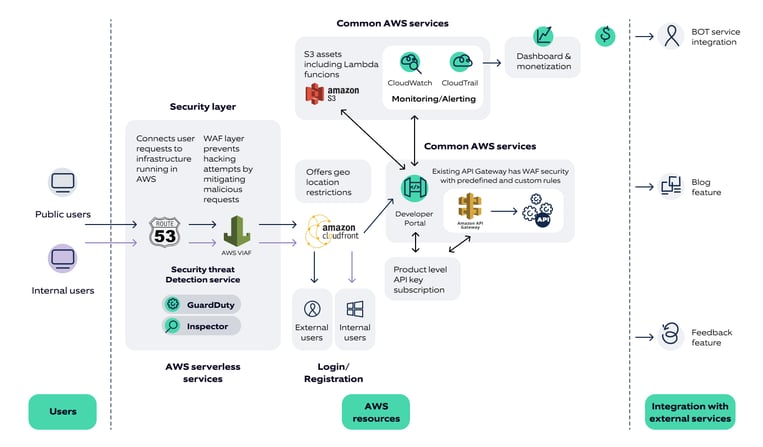It’s said that every challenge comes with an opportunity. Automotive OEMs are constantly under pressure to transform their business models in response to changing consumer expectations and disruptive technologies. API management can help OEMs overcome this challenge. It can help them achieve digital transformation by using their existing systems and data as APIs for easy integration with new digital applications and services. A leading automobile OEM in Asia worked with Nagarro to redesign its enterprise architecture, build a tailored developer portal, and kickstart a group-wide API management initiative.
This article shares five simple steps which can help Automotive OEMs ensure API-enabled business transformation. But that is about the “what”- what steps need to be followed. Before that, let’s first understand the “why” and “how” – why APIM is imperative for automotive OEMs and how OEMs can bring about API-enabled transformation. Let’s get started!
The “why”: Why should automotive OEMs care about API management now?
To transform their business models and operations in response to changing consumer expectations and disruptive new technologies, automotive OEMs are challenged to take proper action. API management can help OEMs achieve digital transformation by enabling them to expose their existing systems and data as APIs, which can be easily integrated with new digital applications and services.
Beyond digital transformation, we see three more reasons for automotive OEMs to deeply care about API management as enabler for seamless, cost-efficient, and secure data exchange within and beyond organizations:
a. We are living in a world with an ever-increasing importance of connected mobility, thanks to the rise of electric and autonomous vehicles, as well as connected car services. API management can help OEMs manage the complexity of these new technologies by providing a unified platform for managing and securing the APIs that power these services.
b. There is an emerging need for ecosystem integration as automotive OEMs must collaborate with a range of partners, such as suppliers, dealers, and third-party service providers, to deliver services and experiences that their customers expect. API management can help them integrate these partners into their ecosystems more easily and securely, by exposing APIs for their services and data.
c. Last but not least, it is important to drive innovation by enabling OEMs to rapidly develop and test new digital services and experiences, and bring them to market more quickly. This can help them stay ahead of the steadily increasing competition.
The ”how”: How does an automotive OEM kickstart API-enabled transformation?
Industry leaders and challengers around the globe team up with Nagarro as strategic IT partners to jointly drive digital transformation and innovation. One of our clients is a leading automobile OEM in Asia, known for its reliable and affordable cars, and for its commitment to innovation and sustainability. As part of its digital transformation strategy, this client was facing the following challenges:
- Data caught in silos due to lack of APIs and API-enabled sharing culture
- No standardization due to the lack of an API governance framework
- Limited API accessibility due to the lack of a central API catalogue
Nagarro addressed the above-mentioned challenges by providing a broad range of services in enterprise architecture consulting, in API development, in DevOps, as well as in the operational support of an API gateway. We have kickstarted a group-wide API management initiative by redesigning the enterprise architecture and building the enterprise-level, secured platform solution based on AWS API Gateway to drive third-party developer engagement. We have also enabled seamless integration between mobile applications and backend systems, such as databases, legacy systems, and cloud services.
The graphic in Figure 1 shows how this developer portal is embedded into the client’s modernized enterprise architecture, providing an overview of the tech stack, based largely on AWS as the preferred public cloud.

Figure 1: Client’s modernized enterprise architecture based on AWS cloud
The tailored developer portal comprises a centralized API catalogue. To populate this API catalogue, we’ve started with onboarding four common APIs to design differentiating customer journey, namely: send one time password (OTP), verify one time password (OTP), register customer, and register customer as a user categorized as general and customer APIs. In just a few months, 100+ APIs have been added to the central catalogue. All APIs in this catalogue are accessible to internal and external developers once they’ve successfully created an account on the developer portal. As part of this developer portal, developers get access to analytics and monitoring capabilities that allow organizations to track API usage, identify usage patterns, and optimize API performance.
With the AWS developer portal, we were able to deliver an efficient platform where only authorized users and applications can access the data and services exposed by the APIs. This reduced the risk of data breaches and unauthorized access and provided a convenient, centralized location for developers to access the necessary resources for building automobile applications. These apps can be APIs, SDKs, documentation, and testing tools which can save time and effort and improve the speed of development. APIs can be used to build cross-platform mobile applications, which can run on multiple devices and platforms. Ultimately, it enables the client to drive a new stream of digital revenue and help in co-creating, co-inventing new market facing products with the partner ecosystem. As a result, the client expects to not only drive end-user value and revenues substantially through direct and indirect monetization, but also expect to fuel the overall API-enabled business transformation towards a mobility-as-a-service provider paradigm.
The “what”: What can automotive OEMs do to move forward in their journey?
To move forward in the API-enabled business transformation journey, we suggest automotive OEMs to consider the following five steps:
1. Identify priorities: Automotive OEMs should first identify the key business priorities they want to achieve through API-enabled business transformation. For example, improving customer experience, driving operational efficiencies, or opening revenue streams. By identifying these priorities, OEMs can focus their efforts on the areas that will have the greatest impact on their business.
2. Develop an API strategy: Once the priorities are identified, automotive OEMs should develop an API strategy that outlines how they will use APIs to achieve their goals. This could include defining the APIs that will be shared, the security and governance measures that will be put in place, and the tools and technologies that will be used to manage and monitor the APIs.
3. Build an API ecosystem: Automotive OEMs should build an API ecosystem that includes internal and external stakeholders such as suppliers, dealers, third-party service providers, and developers. The API ecosystem should enable easy integration of different services and systems, with standardization of data formats and protocols.
4. Ensure API security and governance: Automotive OEMs should ensure that API security and governance measures are in place to protect against cyber threats and data breaches. This includes implementing identity and access management (IAM) policies, data privacy and protection policies, and API usage policies.
5. Monitor and optimize APIs: Finally, automotive OEMs should continuously monitor and optimize their APIs to ensure they are delivering the desired business outcomes. This includes monitoring API usage patterns, performance, and security, and using this data to optimize the API ecosystem and drive continuous improvement.
By following these steps in an aligned manner, automotive OEMs can move forward in API-enabled business transformation and leverage the benefits of improved customer experience, operational efficiencies, and new revenue streams for the combined benefit of customers, employees, and shareholders.






